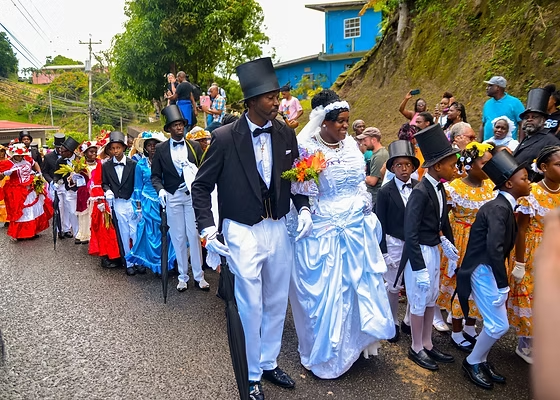Beyond the Beauty: Why the Tobago Ole Time Wedding in Moriah is a Masterclass in Cultural Storytelling and Event Content Creation
- Avion W. Anderson
- Jul 20
- 3 min read
Each year, the village of Moriah in Tobago transforms into a living museum of love, tradition, and communal pride during the Tobago Ole Time Wedding, and this year’s event, held yesterday, was no exception. While many will simply say, “It gets more beautiful every year,” the significance of this event runs much deeper.
The Ole Time Wedding isn’t just a reenactment; it’s a powerful piece of cultural tourism storytelling and an exceptional example of purposeful event content creation in action. It connects generations, educates visitors, and preserves Tobago’s rich heritage in a way that no brochure or social media post could ever fully capture—but that doesn’t stop the cameras from trying.

The Ole Time Wedding: A Cultural Treasure in Motion
Part of the annual Tobago Heritage Festival, the Moriah Ole Time Wedding is one of the most anticipated highlights on the island’s cultural calendar. It recreates the pageantry of a traditional Tobagonian wedding from the post-emancipation era—complete with period costumes, horse-drawn carriages, fife and drum music, and a festive procession through the village.
But it’s more than just a visual spectacle. The event invites both locals and tourists to experience living history, fostering a deeper emotional connection to the island’s past. It’s cultural education wrapped in entertainment, a vital tool for intergenerational storytelling, and a symbol of Tobago’s commitment to preserving its intangible heritage.
Why This Matters for Event Content Creators and Cultural Tourism
For anyone working in event content creation, cultural tourism, or destination marketing, the Tobago Ole Time Wedding offers rich lessons in authentic storytelling, community engagement, and visual branding of heritage experiences.
Here’s why:
1.) - Content That Connects Emotionally
Unlike staged performances or passive exhibitions, the Ole Time Wedding invites active participation. Content creators have the unique opportunity to capture not just images or video, but real emotion: laughter, joy, nostalgia, and the pride of a people celebrating their roots. This type of content builds emotional resonance with audiences far beyond the island’s shores.
2.) - Visual Storytelling Gold
The event is a visual feast. From the elaborate wedding attire styled after the late 1800s to the vibrant crowds lining the streets, every moment offers compelling material for photo essays, reels, documentaries, and social media content. For eco-conscious and purpose-driven content strategists, it’s also a chance to highlight community-based cultural tourism that is sustainable, locally owned, and rooted in heritage preservation.
3.) - Content as Cultural Legacy
By documenting events like the Moriah Ole Time Wedding, content creators play a role in cultural preservation. Every photo, video, blog post, or feature article becomes part of the archival record, helping future generations remember, learn, and celebrate their heritage.
4.) - Destination Storytelling at Its Best
Cultural events like this reposition Tobago not just as a beach destination but as a vibrant cultural hub. Story-driven event content can invite visitors to come for the sun but stay for the culture, encouraging longer stays, deeper engagement, and more meaningful tourism.

The Responsibility of the Content Creator
With an event so rich in meaning, there’s a responsibility to create content that respects the culture, honors the tradition, and celebrates the people who make it possible. This isn’t about extracting moments for likes or views—it’s about curating stories that inspire, educate, and bridge the gap between tourism and heritage preservation.

Final Thoughts
The Tobago Ole Time Wedding in Moriah continues to be more than just a picturesque cultural showcase. It’s a living classroom, a community celebration, and a storytelling platform all rolled into one.
For event content creators, cultural tourism advocates, and heritage marketers, it offers a blueprint for how to transform tradition into compelling content—content that doesn’t just entertain but preserves, connects, and inspires.














Comments